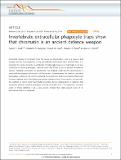Files in this item
Invertebrate extracellular phagocyte traps show that chromatin is an ancient defence weapon
Item metadata
| dc.contributor.author | Robb, Calum | |
| dc.contributor.author | Dyrynda, Elisabeth | |
| dc.contributor.author | Gray, Robert | |
| dc.contributor.author | Rossi, Adriano | |
| dc.contributor.author | Smith, Valerie Jane | |
| dc.date.accessioned | 2019-10-24T10:30:03Z | |
| dc.date.available | 2019-10-24T10:30:03Z | |
| dc.date.issued | 2014-08-13 | |
| dc.identifier | 150656653 | |
| dc.identifier | 73ccf1af-e078-467c-92e2-b743c8457ba0 | |
| dc.identifier | 84907367123 | |
| dc.identifier | 000341057000018 | |
| dc.identifier.citation | Robb , C , Dyrynda , E , Gray , R , Rossi , A & Smith , V J 2014 , ' Invertebrate extracellular phagocyte traps show that chromatin is an ancient defence weapon ' , Nature Communications , vol. 5 , 4627 . https://doi.org/10.1038/ncomms5627 | en |
| dc.identifier.issn | 2041-1723 | |
| dc.identifier.uri | https://hdl.handle.net/10023/18755 | |
| dc.description | Authors thankthe School of Life Sciences (HWU) for the Principal’s Sports Award and a PhD Scholarship to CTR. RDG is funded by a Wellcome Trust fellowship (WT093767). We acknowledge funding from the Medical Research Council, UK (G0601481 and MR/K013386/1) for A.G.R. | en |
| dc.description.abstract | Controlled release of chromatin from the nuclei of inflammatory cells is a process that entraps and kills microorganisms in the extracellular environment. Now termed ETosis, it is important for innate immunity in vertebrates. Paradoxically, however, in mammals, it can also contribute to certain pathologies. Here we show that ETosis occurs in several invertebrate species, including, remarkably, an acoelomate. Our findings reveal that the phenomenon is primordial and predates the evolution of the coelom. In invertebrates, the released chromatin participates in defence not only by ensnaring microorganisms and externalizing antibacterial histones together with other haemocyte-derived defence factors, but crucially, also provides the scaffold on which intact haemocytes assemble during encapsulation; a response that sequesters and kills potential pathogens infecting the body cavity. This insight into the early origin of ETosis identifies it as a very ancient process that helps explain some of its detrimental effects in mammals. | |
| dc.format.extent | 11 | |
| dc.format.extent | 2236611 | |
| dc.language.iso | eng | |
| dc.relation.ispartof | Nature Communications | en |
| dc.subject | QH301 Biology | en |
| dc.subject | BDC | en |
| dc.subject | R2C | en |
| dc.subject.lcc | QH301 | en |
| dc.title | Invertebrate extracellular phagocyte traps show that chromatin is an ancient defence weapon | en |
| dc.type | Journal article | en |
| dc.contributor.institution | University of St Andrews. School of Biology | en |
| dc.contributor.institution | University of St Andrews. Scottish Oceans Institute | en |
| dc.identifier.doi | https://doi.org/10.1038/ncomms5627 | |
| dc.description.status | Peer reviewed | en |
This item appears in the following Collection(s)
Items in the St Andrews Research Repository are protected by copyright, with all rights reserved, unless otherwise indicated.

